
NOAA has issued their forecast for the distribution of smoke for 10 a.m. PDT July 11, 2022. The smoke is primarily originating from wildfires in California and Utah.
News and opinion about wildland fire
For 10 a.m. PDT July 11, 2022

NOAA has issued their forecast for the distribution of smoke for 10 a.m. PDT July 11, 2022. The smoke is primarily originating from wildfires in California and Utah.
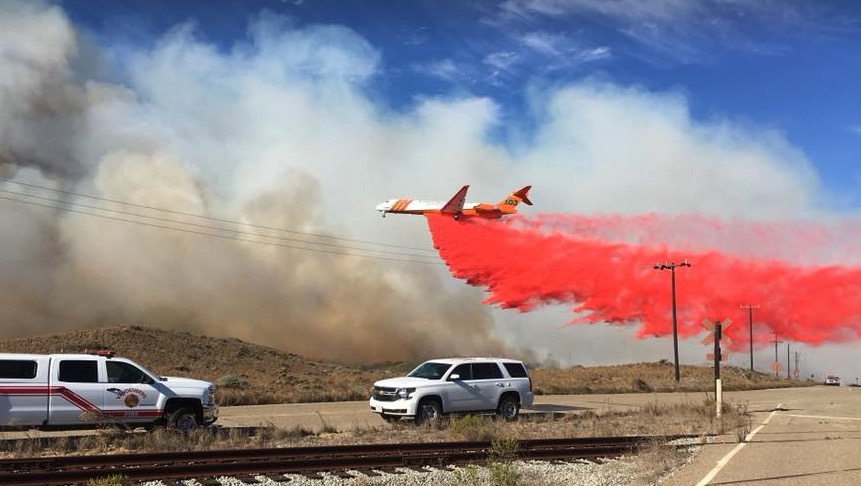
This article was first published at Fire Aviation
Yesterday July 9 a lead plane and a large air tanker had a close call while on a retardant dropping sortie on the Washburn Fire in Yosemite National Park.
There was virtually no wind over the fire most of the day and the area was smoked in causing very poor visibility making it impossible for air tankers to drop on the fire. But by 6 p.m. conditions had improved and at about 6:10 p.m. a lead plane was leading Tanker 103, an MD-87, over a target when they saw a falling tree branch above the lead plane. It fell between the two aircraft, in front of the tanker.
Twitter user Robert, @Rob_on_sisukas, captured an audio recording of the radio conversation. We’re not sure who the lead plane pilot was talking to, but we’ll call it “dispatcher” for now:
LEAD PLANE: Hey I just want to let you know that a branch went right over the top of us, pretty good size, probably 50 feet above us coming down and fell right in between Tanker 103 and myself.
DISPATCHER: OK. Copy. So it’s repeat of yesterday’s (unintelligible)
LEAD PLANE: That’s exactly what I’m getting at. So if we keep seeing that we might have to knock it off. I don’t want to take a chance on busting a window in an airplane or hurting an aircraft for this.
DISPATCHER: Absolutely. Keep me updated on this.
#WashburnFire interesting little chat. Near miss with a tree branch and Air Attack and Tanker 103. As civilians, we just see planes dropping loads. But listen to this choreography that goes on behind the scenes of fire. pic.twitter.com/Dn2CcTZ7qV
— Robert (@Rob_on_sisukas) July 10, 2022
When a fire is burning intensely in an unstable atmosphere the convection in the rising smoke column can be powered by a tremendous amount of energy. As air at ground level rushes in to take the place of the rising column, the developing horizontal wind and the fresh oxygen feed the fire, causing an even higher level of intensity. The horizontal and then vertical movement of air can sometimes transport unexpectedly large objects up into the sky. Large columns may rotate as they rise and in extreme cases can actually become a fire tornado. You don’t want to be nearby when that happens. Fire tornados are not to be confused with small dust devils or fire whirls.
What is surprising about the incident yesterday is that the fire was smoked in most of the day, and tankers could not fly until about 6 p.m. I looked at various AlertWildfire cameras a few times and did not see any smoke columns. Maybe the cameras I saw were not able to see all of the fire, but I remember that late in the afternoon fire activity increased at the Sierra Fire Watch camera below, and columns may have developed.
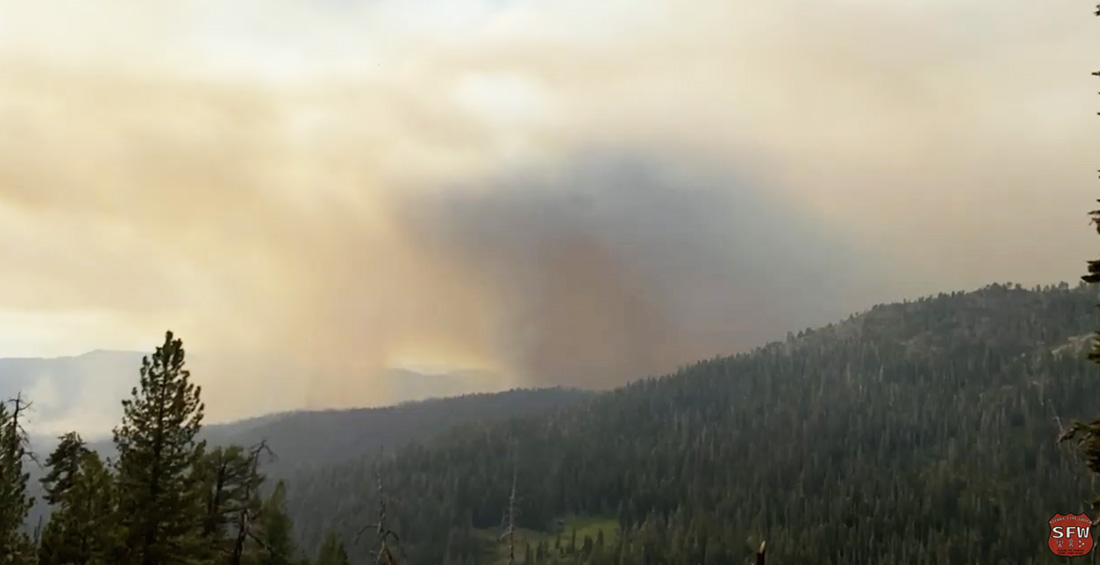
Firefighting aircraft being damaged by debris being lofted into the air over a fire is not unheard of. Here’s part of an article I wrote for Wildfire Today in 2018:
During the large vegetation fires in southern California in 2003 some of the convection columns were so powerful that the windshields on six air tankers were cracked by chunks of debris that were being hurled into the air (page D-6 in 2003 California Governor’s Blue Ribbon Report; huge 20 Mb file). One pilot saw a four by eight sheet of plywood sail past at 1,500 feet.
As of late morning today, July 10, the Washburn Fire has burned about 1,800 acres in Yosemite National Park. About 300 of those acres are in the Mariposa Grove of giant sequoia trees, some of them 3,000 years old.
Thanks and a tip of the hat go out to Kelly.
It has burned into a grove of giant sequoia trees, some of which are 3,000 years old
Updated 5:08 p.m. PDT July 11, 2022
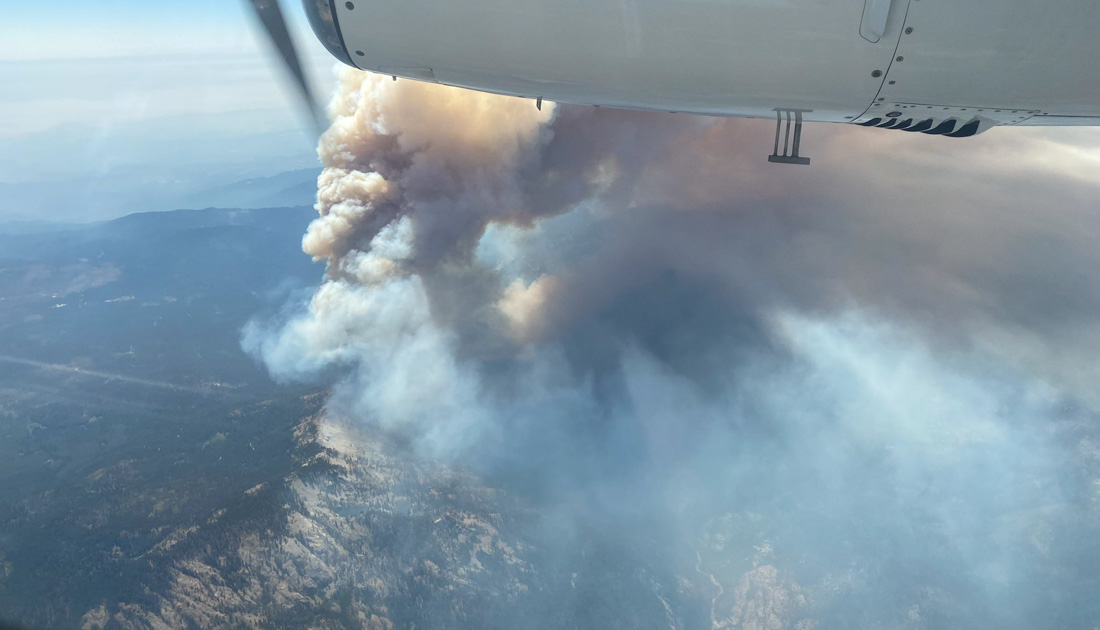
Late Monday afternoon activity on the Washburn Fire increased substantially. There have been reports of at least one spot fire on the north side of the South Fork of the Merced River. There were also reports of spot fires across highway 41 on the west or northwest side of the fire.
Satellite heat detections at 2:36 p.m. Monday showed numerous heat sources east of the earlier perimeter of the fire across the park boundary on the Sierra National Forest, and on the northwest side of the fire between Highway 41 and the river.
In mid-afternoon the FIRIS aircraft mapped the fire at 2,720 acres.

Updated 7:11 a.m. PDT July 11, 2022
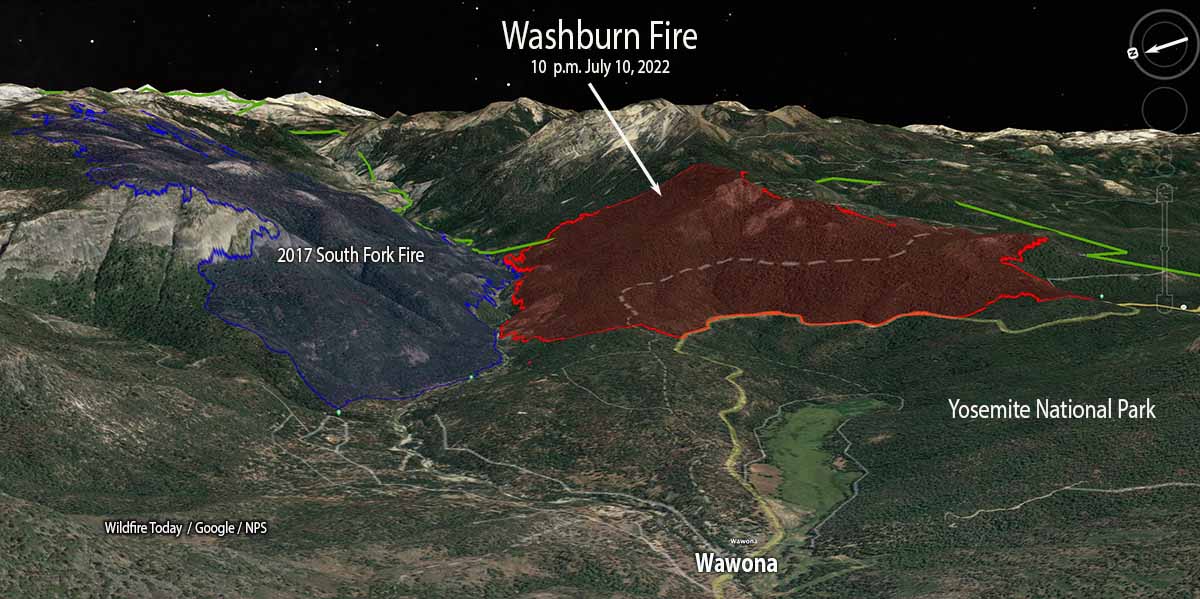
The Washburn Fire in Yosemite National Park in California continued to spread west, north, and east on Sunday. On Saturday and Sunday the size increased by 749 acres, bringing the total to 2,340 acres according to a mapping flight Sunday at 10 p.m.
Approximately 340 acres of the fire are within the Mariposa Grove of giant sequoias. While protective foil-based structure wrap is not being used on the sequoias themselves, additional methods are being employed including the removal of fuels around the trees, and ground-based sprinkler systems to increase humidity and fuel moisture near the sequoias. The Mariposa Grove has a long history of prescribed burning and studies have shown that these efforts reduce the impacts of high-severity fire.

Firefighters are constructing direct fireline on the fire edge where possible, but are also using tactical firing to tie it in with barriers, such as Highway 41 on the west side.
Evacuations are in effect in the Wawona area. A map is available showing the locations. The Wawona Road (Highway 41) is closed from the South Entrance to Henness Ridge Road. Yosemite West remains accessible from the northern side of the Wawona road.

The weather forecast for the fire area (6,400 feet above sea level) predicts for Monday and Tuesday 81 degrees, 3 to 8 mph west and southwest winds, relative humidity in the low to mid-20s, partly cloudy skies, and no chance of rain.
Updated 5:34 p.m. PDT July 10, 2022
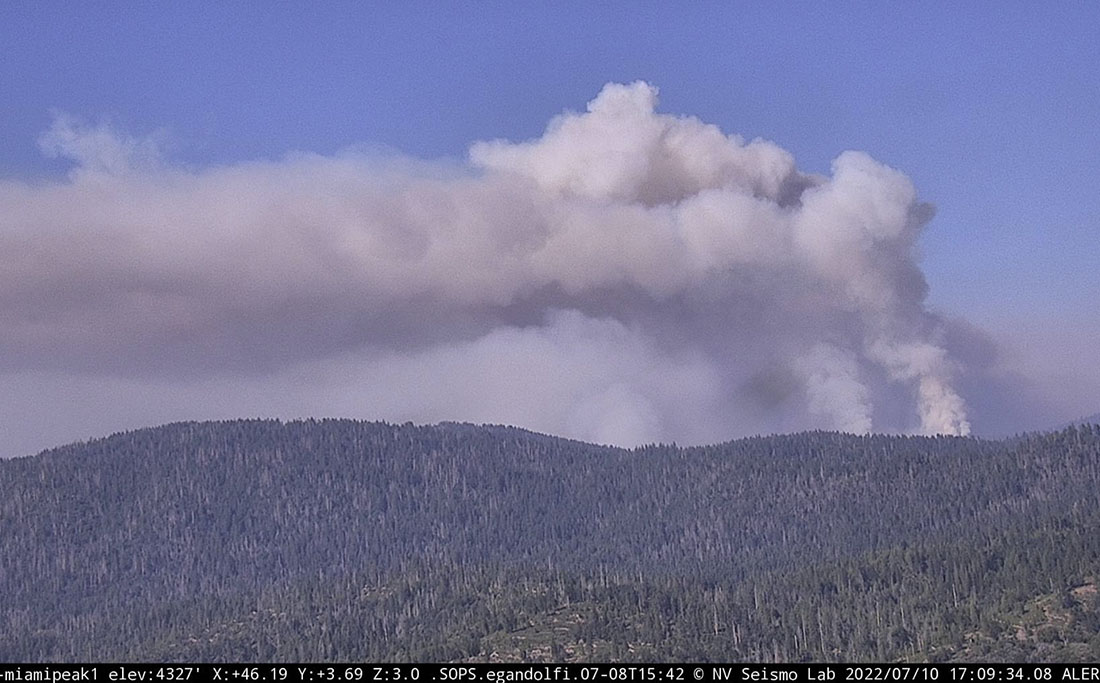
The Washburn Fire, part of which is burning in a grove of giant sequoias in Yosemite National Park, has grown to 2,045 acres, according to a mapping flight at about 4 p.m. Saturday. Most of the additional acres are on the north and east sides. It spread closer to the South Fork of the Merced River, but at that time had not crossed. The east side has moved across the county line, from Mariposa into Madera county.

Three large air tankers and a very large air tanker dropped retardant along a ridge in mid-afternoon, pretreating it in anticipation that when the fire reaches that location the spread will be slowed or stopped.
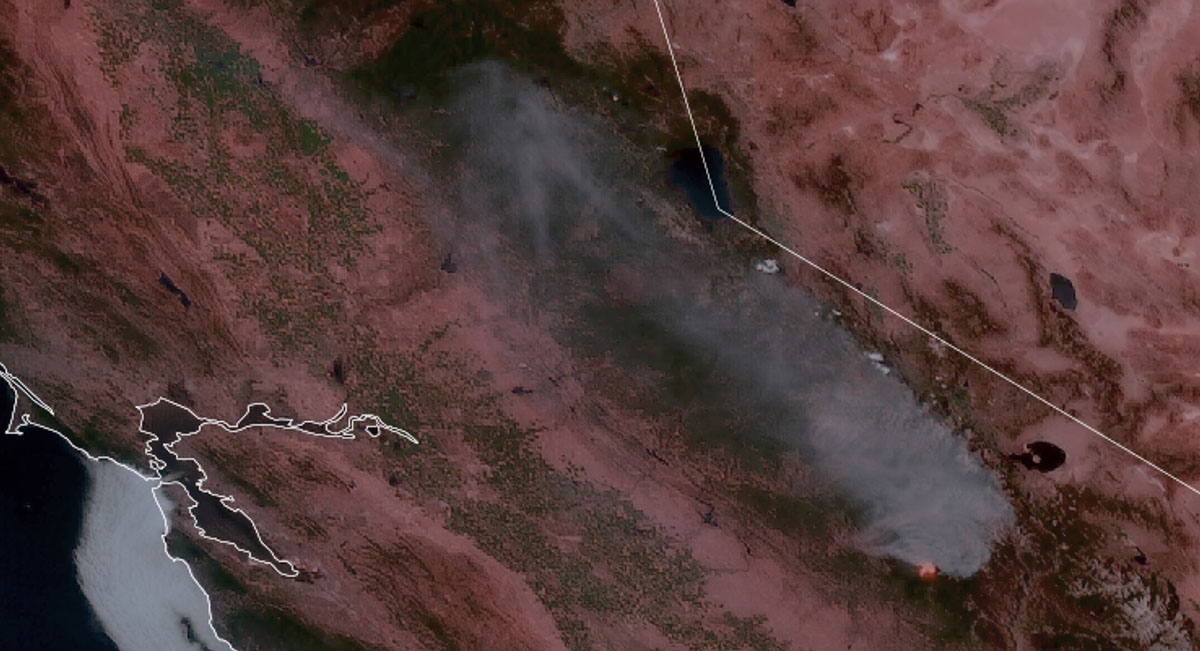
Late in the afternoon the fire activity increased substantially, sending up a substantial smoke column which was blown off to the north.
9:11 a.m. PDT July 10, 2022
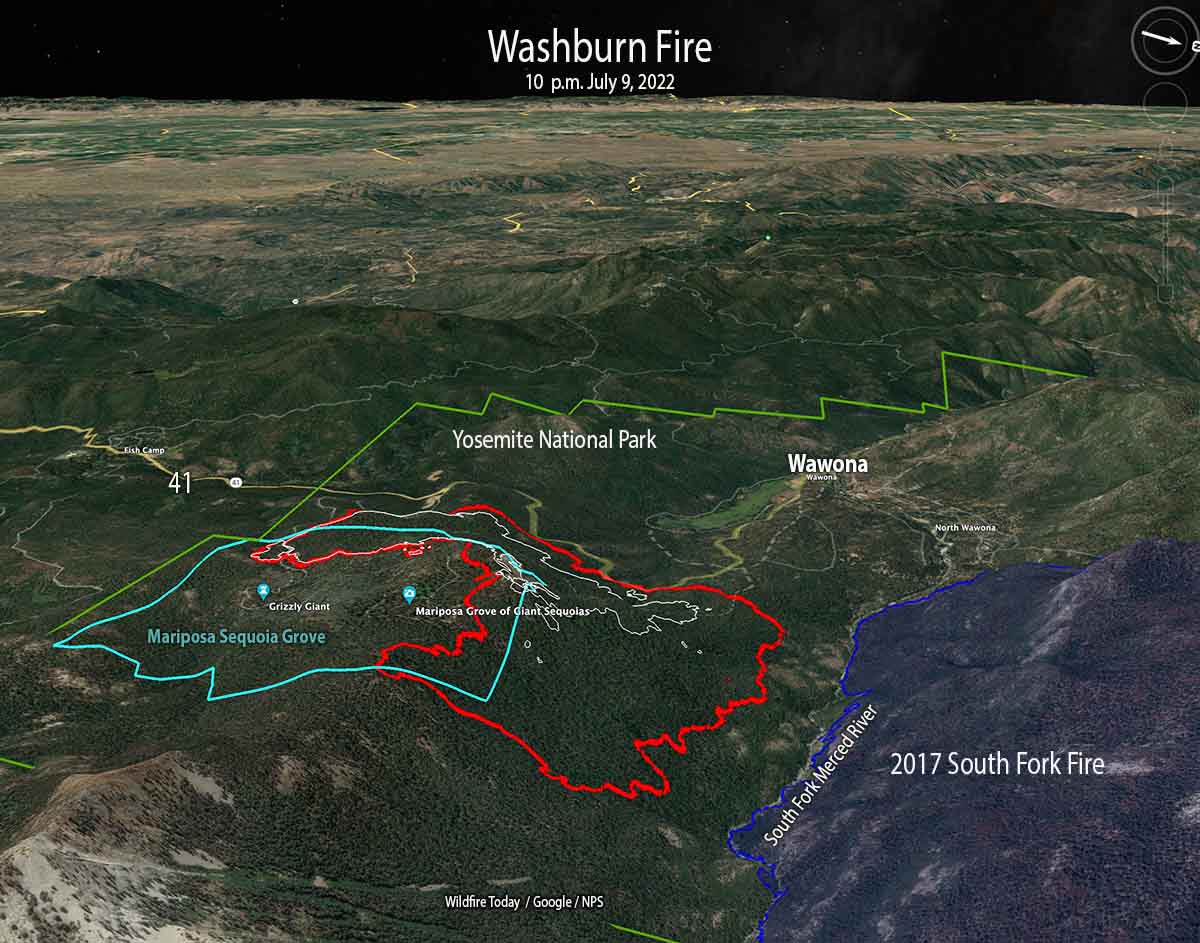
With very little wind Saturday, the Washburn Fire continued to spread in and adjacent to the Mariposa grove of giant sequoia trees in Yosemite National Park in California. In spite of the relatively mild weather conditions, spot fires are occurring hundreds of feet out in front of the leading edge. The growth into the grove has been limited due to previous prescribed fires that reduced the amount of fuel on the ground, and by the efforts of firefighters. Some of the trees are about 3,000 years old.
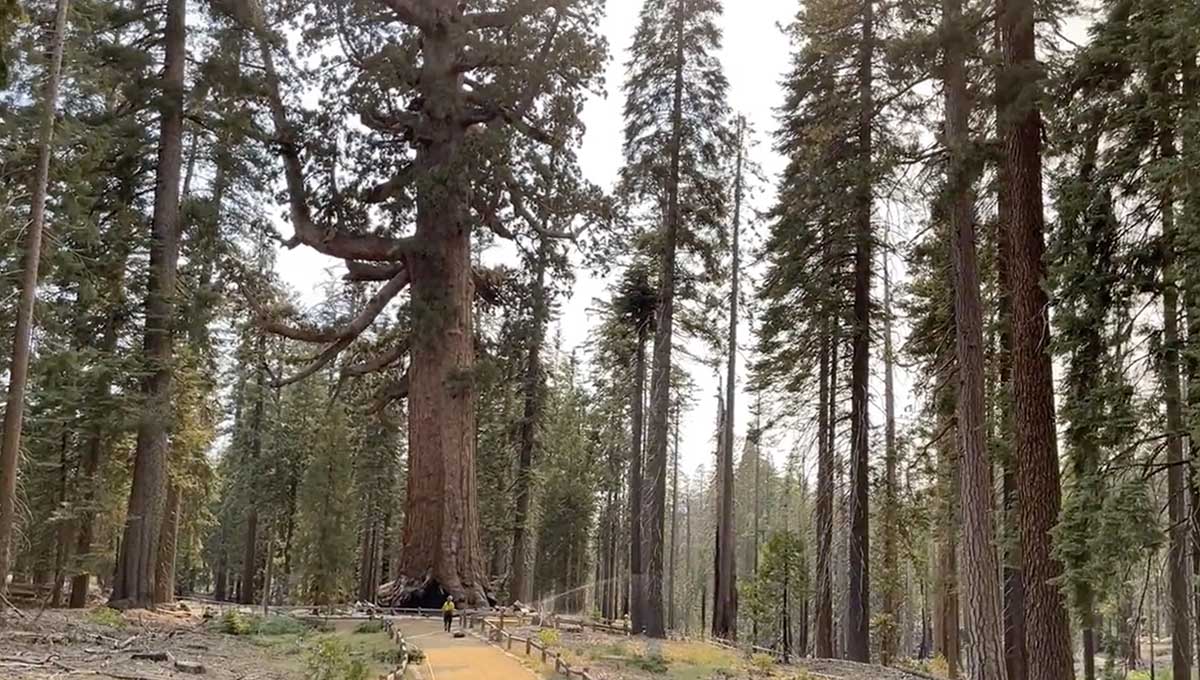
While the huge, very old trees are adapted to fire, they are not prepared for human caused climate change and the current “exceptional drought” conditions that have led to low soil and fuel moistures. The monster trees are more vulnerable to the existing weather and fuel conditions. They only grow in about 70 groves located on the western slopes of California’s Sierra Nevada Mountains. They are the largest trees on Earth in terms of volume.
The fire was mapped Friday night at 1,591 acres. Approximately 300 acres are in the Mariposa Grove of giant sequoias, on the west and north sides.
Smoke at times on Saturday degraded visibility to the point where retardant-dropping aircraft were grounded. Most of the movement of the fire was on the north end where it is working its way down-slope to the South Fork of the Merced River, which is also the southern edge of the South Fork Fire that burned 7,563 acres in 2017. The footprint of that 5-year-old fire scar will not stop the fire by itself, but there will be less resistance to control as it spreads through the lighter fuels.
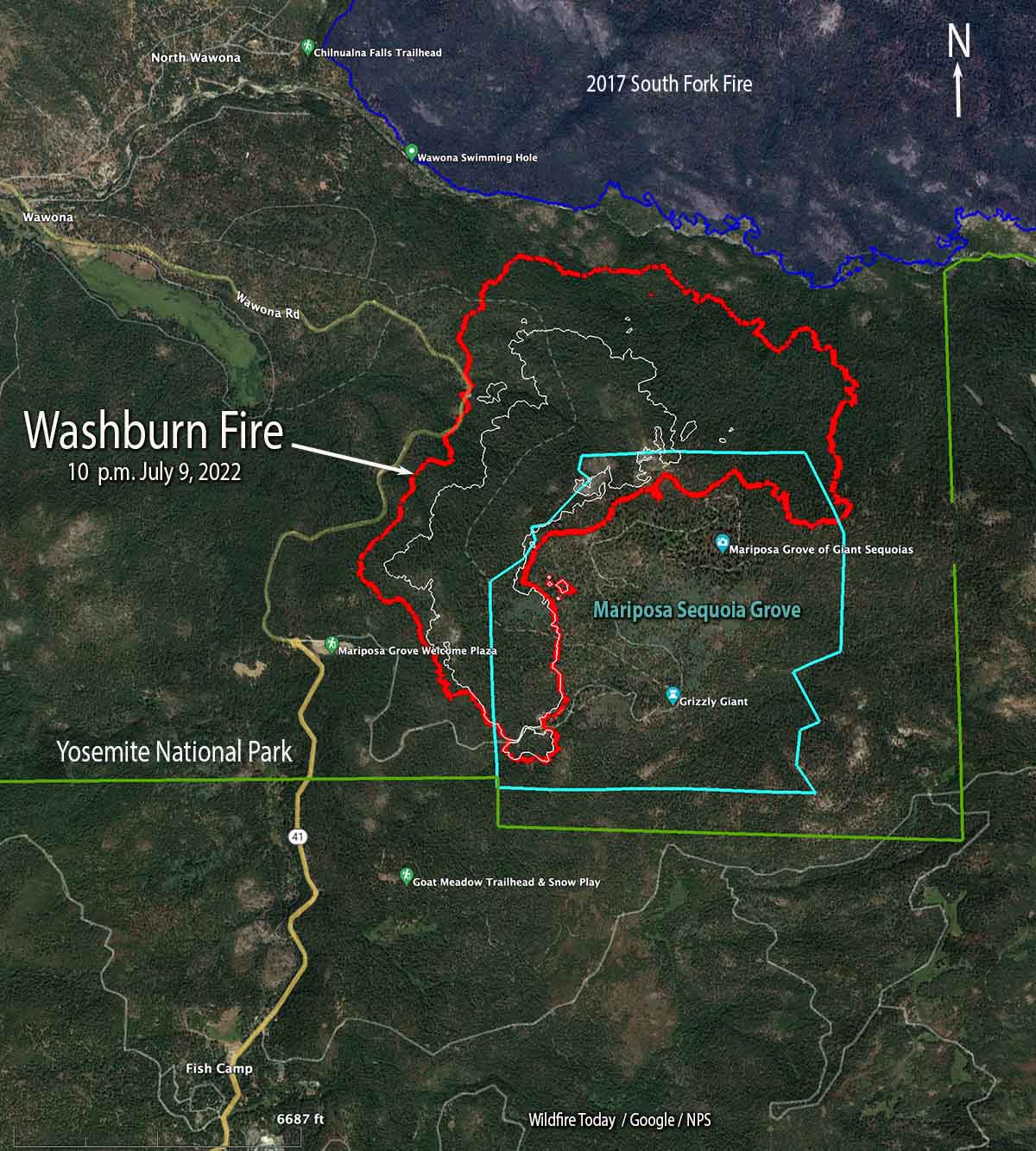
The Washburn Fire is burning in mostly high load conifer litter with a heavy dead and down component as well as numerous standing dead trees.
There was very little wind on the fire Saturday and none overnight at Fish Camp, south of the fire and 1,000 feet lower where the minimum humidity Saturday was 31 percent but rose to 83 percent by 7:31 a.m. Sunday. Warmer and drier weather is predicted for the next few days.
The weather forecast for the fire area on Sunday calls for temperature around 80, relative humidity 26 percent, and ridgetop winds out of the west at 5 mph gusting to 12 mph in the afternoon. For Sunday night, 66 degrees, 33 percent RH, and 5 to 10 mph northwest winds in the evening shifting to east after 9 p.m. Monday should bring 83 degrees, 20 percent RH, and 5 to 10 mph winds out of the southeast shifting to southwest by 11 a.m.
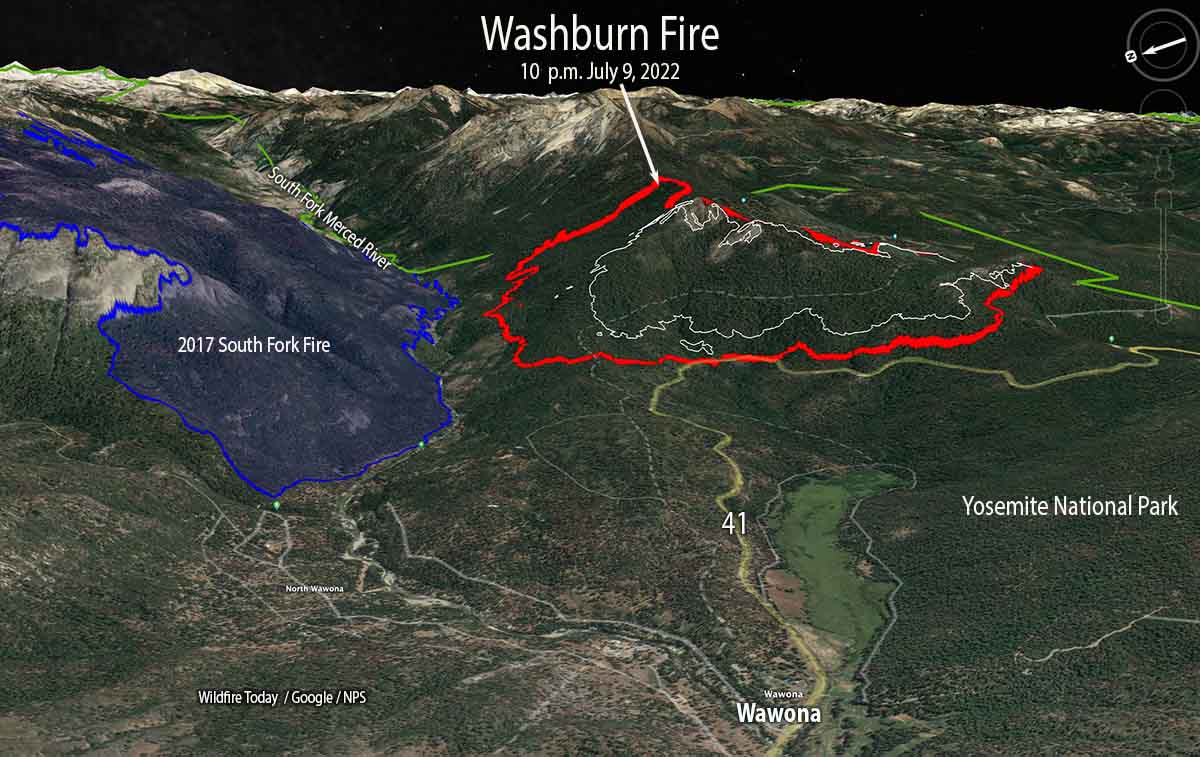
Preparing for fire: The Grizzly Giant is the most renowned giant sequoia in Yosemite National Park. Standing at 209 feet it is the second largest tree in the Yosemite, and one of the most photographed.The Grizzly Giant is in the Mariposa Grove impacted by the Washburn Fire. pic.twitter.com/jnIlm9Gemn
— Yosemite Fire and Aviation Management (@YosemiteFire) July 10, 2022
Will add 1,503 personnel, 27 engines, 4 helicopters, and 10 dozers
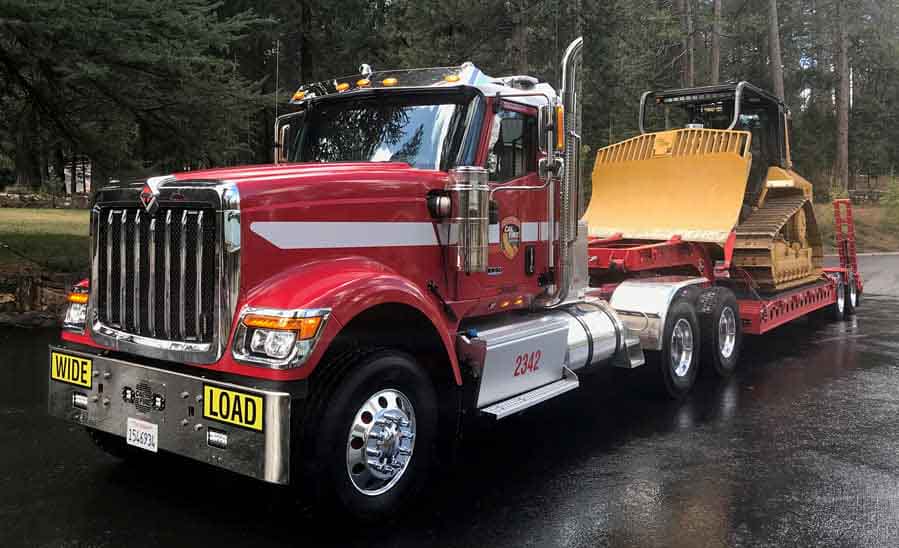
The new budget for California signed into law June 30 by Governor Gavin Newsom includes a massive increase for the California Department of Forestry and Fire Protection (CAL FIRE) for the fiscal year that began July 1, 2022.
Firefighters
The budget authorizes 11,293 positions, a 13 percent increase of 1,503 personnel.
Helicopters
To add to the 12 new S70i Firehawk helicopters that were funded a couple of years ago, they will spend $99 million to purchase an additional 4 to help maintain continuous flight operations during critical fire weather conditions when frontline helicopters are due for maintenance.
In addition, $45 million is set aside annually for the next three years to secure exclusive use (EU) contracts for 10 additional helitankers while awaiting the federal delivery of seven former Coast Guard C-130 air tankers that over the last 9 years have been waiting for the US Air Force to convert them into retardant-dropping air tankers.
CAL FIRE Director Joe Tyler told Fire Aviation in March that the incorporation of the seven former Coast Guard C-130 aircraft into the state’s air tanker fleet might be pushed back to 2024 due the pandemic/endemic and supply chain issues. This is in spite of the agency’s efforts in attempting to facilitate movement in the project. He said they had hoped to see some of the C-130s flying on fires this year. CAL FIRE is working with the Coast Guard, the Air Force, and the contractor who will install the retardant delivery system, Coulson Aviation.
California Conservation Corps (CCC) and California Military Department (CMD) Hand Crews
Appropriated is $104 million and 238 positions starting now, and $50 million and 270 positions phased in over five years. Eight additional year-round hand crews will be added and 16 seasonal hand crews will be converted to year-round.
Four existing seasonal CAL FIRE/CCC hand crews will convert to year-round staffing in July 2022 and the personnel for the remaining two transitioned seasonal hand crews will be hired beginning January 2023. On these hand crews, two temporary Fire Captains (FC) per hand crew are replaced by three permanent FCs and three new FAEs are added to each hand crew. In total, 18 FCs and 18 FAEs will staff all six hand crews.
Ten existing seasonal CMD hand crews will be converted to year-round and four year-round CMD hand crews will be added for statewide response and fuels reduction projects.
Engines and Dozers
$36 million will be used to acquire surge capacity fire engines and bulldozers. This will add two additional engines in each of the 21 Units and six contract counties, plus 10 additional bulldozers. These resources will be available to be staffed during times of resource drawdown and critical fire activity.
Approximately $9 million will be used to hire support staff for the Firehawk program and positions for the contract EU helicopters,
July through December Fire Protection Augmentation
One-time funding of $83.1 million General Fund is available to augment fire protection resources from July through December 2022 given trends associated with climate change and current drought conditions, increasing fire severity and size, and declining inmate camp populations. It will be used to extend the staffing of 16 additional CAL FIRE firefighter hand crews through December 2022, plus support staff and training.
Halfway Hill Fire and Dry Creek Fire were reported about the same time on Friday, July 8
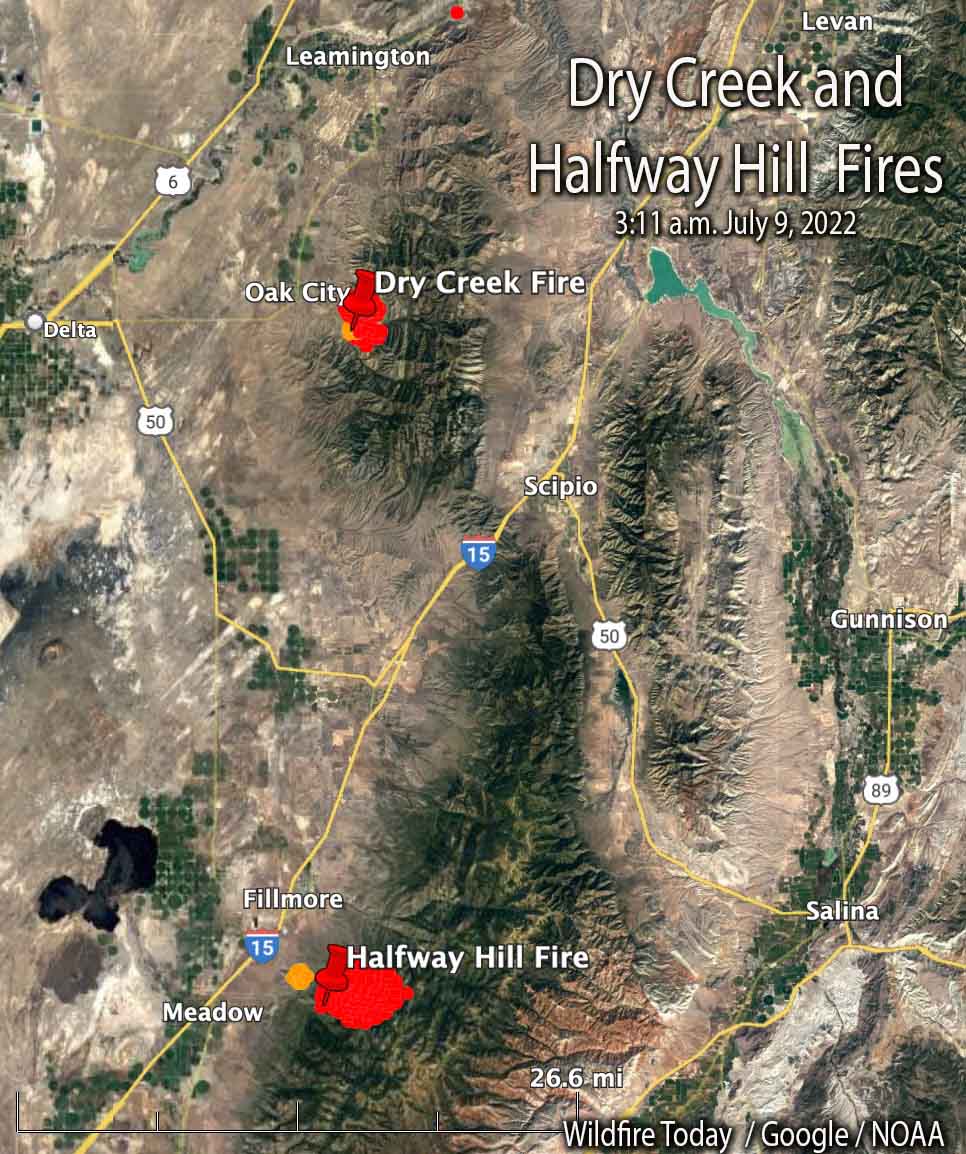
Firefighters are working on two fires in Central Utah that were reported Friday 14 minutes apart, separated by 28 air miles.
The Halfway Hill Fire spread rapidly about one mile east of Interstate 15, 2 miles southeast of Fillmore. On Friday the Millard County Sheriff’s Office ordered evacuations for the Virginia Hills subdivision southeast of Fillmore. Utah Fire Information reported Saturday morning it had burned 6,644 acres since it was reported at 3:13 p.m. July 8. At 12:30 p.m. on Saturday aircraft spotted working the fire included four single engine air tankers and two large RJ85 air tankers. They were reloading with retardant at Cedar City.
The blaze started while the relative humidity was 10 percent with a 15 mph wind gusting out of the southwest at up to 30 mph. Conditions are about the same Saturday afternoon.
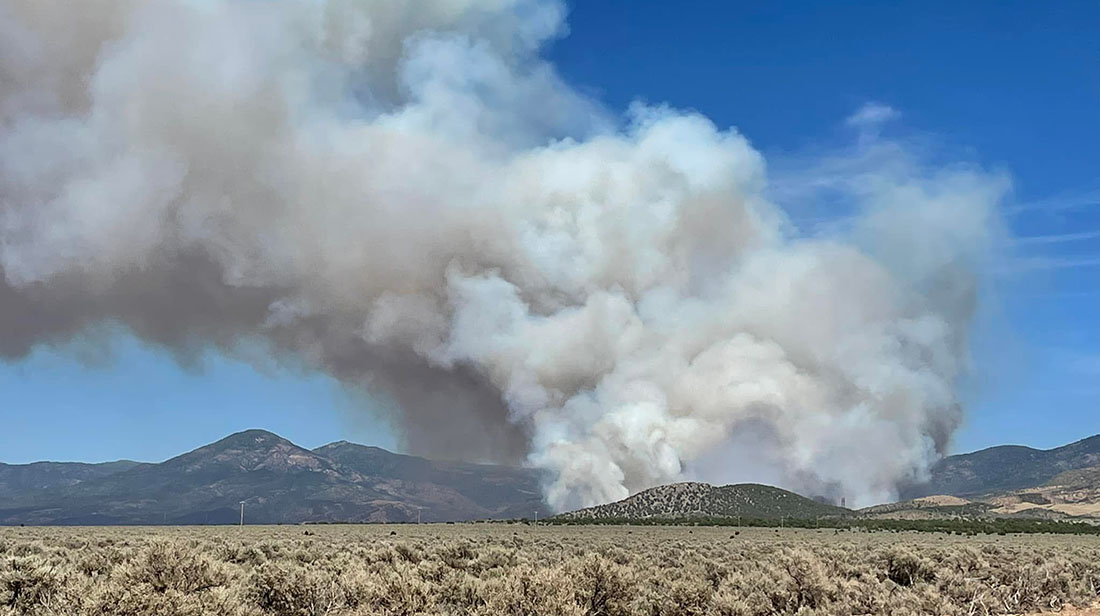
The 1,200-acre Dry Creek Fire is 10 miles west of Interstate 15, 2 miles east of Oak City.
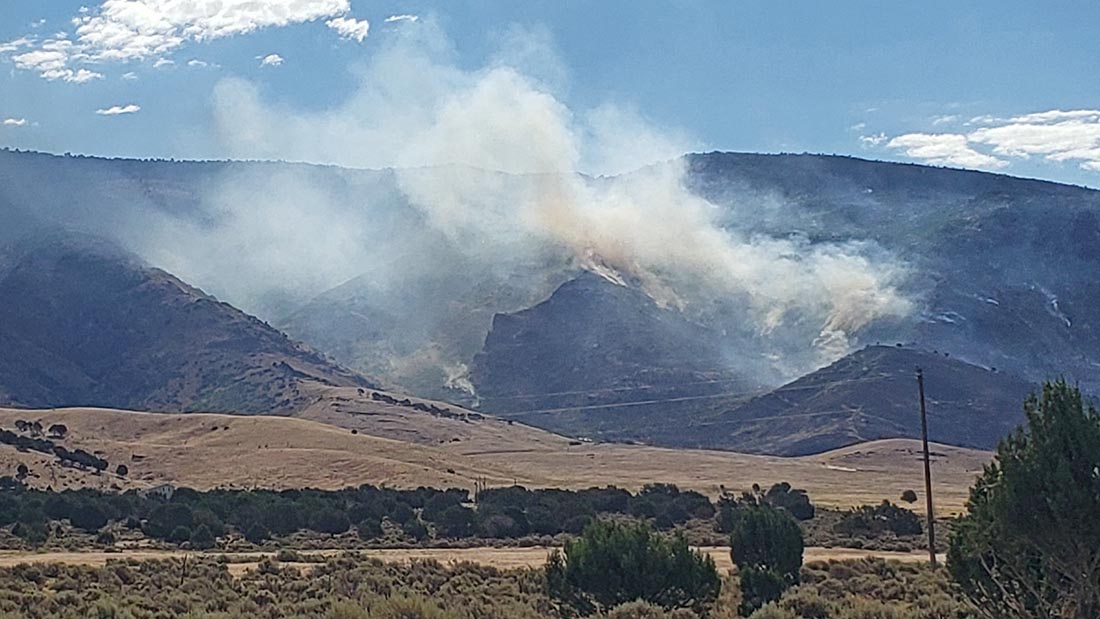
While the Forest Supervisor of the Santa Fe National Forest, Debbie Cress, is temporarily assigned to the acting Deputy Chief of Staff position for the U.S. Forest Service in Washington, James Duran will serve as acting Supervisor for the next four months. This is occurring while the largest fire in the recorded history of New Mexico, the Hermits Peak / Calf Canyon Fire, is still not officially contained.
From the Associated Press:
Some have questioned the timing given that the wildfire has yet to be declared contained and recovery work has just begun.Forest officials have dismissed criticism, saying the opportunity for Cress to work at headquarters initially came up in January and was the culmination of her work over the past year with the agency’s leadership.
Cress acknowledged in a statement Friday that it was difficult timing as her home state deals with the aftermath of the massive wildfire.

The 341,735-acre fire is the result of two prescribed fires on the Santa Fe National Forest that escaped control. One was a broadcast burn that crossed control lines during a strong wind. The other originated from slash piles that were ignited in late January that continued burning for months. In mid-April one or more of the piles became very active and began spreading and merged with the other escaped fire on April 22.
In 2018 another pile burning project on the Santa Fe escaped months after it was ignited and had to be converted to a wildfire. A Facilitated Learning Analysis found that “communication” and “prescribed fire preparation and risk” were common themes.
Ms. Cress began as the Forest Supervisor in April of 2021. Three months before, the Santa Fe New Mexican reported, she had transferred from a District Ranger position in Arizona to be the Deputy Forest Supervisor on the Santa Fe National Forest.
Thanks and a tip of the hat go out to Jim and Gerald.